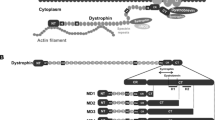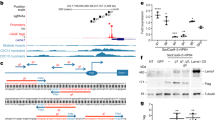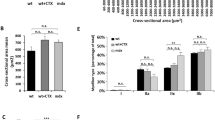Abstract
Rescue of dystrophic skeletal muscle in mdx and utrophin/dystrophin-deficient (dko) mouse models by reintroduction of dystrophin has validated gene therapy as a potential therapeutic approach for Duchenne muscular dystrophy. However, the size of the dystrophin gene exceeds the capacity of adeno-associated viral (AAV) vectors. Dystrophin provides a mechanical link at the muscle membrane by direct binding of its amino-terminal and cysteine-rich domains to actin and a transmembrane protein complex, respectively. It has not been investigated whether restoration of these two tethering functions by two separate dystrophin molecules is sufficient to prevent dystrophic pathologies. We examine the effect of coexpression of the amino-terminal and cysteine-rich domains from separate dystrophin transgenes, Δcys and Dp71, on the dystrophic phenotype. Expression of individual dystrophin domains from multiple vectors would effectively expand AAV capacity. Although both Δcys and Dp71 colocalize at the membrane, there is no improvement of dystrophic pathology. The fiber-type and neuromuscular junction abnormalities of dko mice that are ameliorated by the Δcys transgene are not further improved or disrupted by Dp71. Separate truncated dystrophins, which together restore all protein interactions and scaffolding for signaling molecules, are not sufficient to ameliorate the dystrophic phenotype and therefore dystrophin domains in trans cannot be used to increase the effective cloning capacity for AAV-mediated gene therapy.
This is a preview of subscription content, access via your institution
Access options
Subscribe to this journal
Receive 12 print issues and online access
$259.00 per year
only $21.58 per issue
Buy this article
- Purchase on Springer Link
- Instant access to full article PDF
Prices may be subject to local taxes which are calculated during checkout




Similar content being viewed by others
References
Ahn AH, Kunkel LM . The structural and functional diversity of dystrophin. Nat Genet 1993; 3: 283–291.
Emery AEH . Duchenne Muscular Dystrophy, 2nd edn. Oxford University Press: Oxford, 1993.
Byers TJ, Kunkel LM, Watkins SC . The subcellular distribution of dystrophin in mouse skeletal, cardiac, and smooth muscle. J Cell Biol 1991; 115: 411–421.
Koenig M, Hoffman EP, Bertelson CJ, Monaco AP, Feener C, Kunkel LM . Complete cloning of the Duchenne muscular dystrophy (DMD) cDNA and preliminary genomic organization of the DMD gene in normal and affected individuals. Cell 1987; 50: 509–517.
Ervasti JM, Campbell KP . Membrane organization of the dystrophin-glycoprotein complex. Cell 1991; 66: 1121–1131.
Ervasti JM, Campbell KP . A role for the dystrophin-glycoprotein complex as a transmembrane linker between laminin and actin. J Cell Biol 1993; 122: 809–823.
Rafael JA, Cox GA, Corrado K, Jung D, Campbell KP, Chamberlain JS . Forced expression of dystrophin deletion constructs reveals structure- function correlations. J Cell Biol 1996; 134: 93–102.
Rando TA . The dystrophin-glycoprotein complex, cellular signaling, and the regulation of cell survival in the muscular dystrophies. Muscle Nerve 2001; 24: 1575–1594.
Spence HJ, Dhillon AS, James M, Winder SJ . Dystroglycan, a scaffold for the ERK-MAP kinase cascade. EMBO Rep 2004; 5: 484–489. Epub 2004 Apr 2008.
Hoffman EP, Brown Jr RH, Kunkel LM . Dystrophin: the protein product of the Duchenne muscular dystrophy locus. Cell 1987; 51: 919–928.
Sicinski P, Geng Y, Ryder-Cook AS, Barnard EA, Darlison MG, Barnard PJ . The molecular basis of muscular dystrophy in the mdx mouse: a point mutation. Science 1989; 244: 1578–1580.
Chapman VM, Miller DR, Armstrong D, Caskey CT . Recovery of induced mutations for X chromosome-linked muscular dystrophy in mice. Proc Natl Acad Sci USA 1989; 86: 1292–1296.
Torres LF, Duchen LW . The mutant mdx: inherited myopathy in the mouse. Morphological studies of nerves, muscles and end-plates. Brain 1987; 110: 269–299.
Deconinck AE, Rafael JA, Skinner JA, Brown SC, Potter AC, Metzinger L et al. Utrophin-dystrophin-deficient mice as a model for Duchenne muscular dystrophy. Cell 1997; 90: 717–727.
Rafael JA, Townsend ER, Squire SE, Potter AC, Chamberlain JS, Davies KE . Dystrophin and utrophin influence fiber-type composition and post-synaptic membrane structure. Hum Mol Genet 2000; 9: 1357–1367.
Buchthal F, Schmalbruch H, Kamieniecka Z . Contraction times and fiber types in patients with progressive muscular dystrophy. Neurology 1971; 21: 131–139.
Cox GA, Cole NM, Matsumura K, Phelps SF, Hauschka SD, Campbell KP et al. Overexpression of dystrophin in transgenic mdx mice eliminates dystrophic symptoms without toxicity. Nature 1993; 364: 725–729.
Phelps SF, Hauser MA, Cole NM, Rafael JA, Hinkle RT, Faulkner JA et al. Expression of full-length and truncated dystrophin mini-genes in transgenic mdx mice. Hum Mol Genet 1995; 4: 1251–1258.
Athanasopoulos T, Graham IR, Foster H, Dickson G . Recombinant adeno-associated viral (rAAV) vectors as therapeutic tools for Duchenne muscular dystrophy (DMD). Gene Therapy 2004; 11: S109–121.
Lederfein D, Levy Z, Augier N, Mornet D, Morris G, Fuchs O et al. A 71-kilodalton protein is a major product of the Duchenne muscular dystrophy gene in brain and other nonmuscle tissues. Proc Natl Acad Sci USA 1992; 89: 5346–5350.
Cox GA, Sunada Y, Campbell KP, Chamberlain JS . Dp71 can restore the dystrophin-associated glycoprotein complex in muscle but fails to prevent dystrophy. Nat Genet 1994; 8: 333–339.
Harper SQ, Hauser MA, DelloRusso C, Duan D, Crawford RW, Phelps SF et al. Modular flexibility of dystrophin: implications for gene therapy of Duchenne muscular dystrophy. Nat Med 2002; 8: 253–261.
Fabb SA, Wells DJ, Serpente P, Dickson G . Adeno-associated virus vector gene transfer and sarcolemmal expression of a 144 kDa micro-dystrophin effectively restores the dystrophin-associated protein complex and inhibits myofibre degeneration in nude/mdx mice. Hum Mol Genet 2002; 11: 733–741.
Gregorevic P, Blankinship MJ, Allen JM, Crawford RW, Meuse L, Miller DG et al. Systemic delivery of genes to striated muscles using adeno-associated viral vectors. Nat Med 2004; 10: 828–834. Epub 2004 Jul 2025.
Sun L, Li J, Xiao X . Overcoming adeno-associated virus vector size limitation through viral DNA heterodimerization. Nat Med 2000; 6: 599–602.
Yan Z, Zhang Y, Duan D, Engelhardt JF . Trans-splicing vectors expand the utility of adeno-associated virus for gene therapy. Proc Natl Acad Sci USA 2000; 97: 6716–6721.
Yan Z, Ritchie TC, Duan D, Engelhardt JF . Recombinant AAV-mediated gene delivery using dual vector heterodimerization. Methods Enzymol 2002; 346: 334–357.
Yang J, Zhou W, Zhang Y, Zidon T, Ritchie T, Engelhardt JF . Concatamerization of adeno-associated virus circular genomes occurs through intermolecular recombination. J Virol 1999; 73: 9468–9477.
Dunckley MG, Wells KE, Piper TA, Wells DJ, Dickson G . Independent localization of dystrophin N- and C-terminal regions to the sarcolemma of mdx mouse myofibres in vivo. J Cell Sci 1994; 107: 1469–1475.
Rafael JA, Sunada Y, Cole NM, Campbell KP, Faulkner JA, Chamberlain JS . Prevention of dystrophic pathology in mdx mice by a truncated dystrophin isoform. Hum Mol Genet 1994; 3: 1725–1733.
Hainsey TA, Senapati S, Kuhn DE, Rafael JA . Cardiomyopathic features associated with muscular dystrophy are independent of dystrophin absence in cardiovasculature. Neuromuscul Disord 2003; 13: 294–302.
Acknowledgements
This work was supported by the Muscular Dystrophy Association and a Career Award in the Biomedical Sciences from the Burroughs Wellcome Fund (to JRF). KLG was supported by a Chemistry/Biology Interface training grant from NIH (T32 GM08512).
Author information
Authors and Affiliations
Corresponding author
Rights and permissions
About this article
Cite this article
Gardner, K., Kearney, J., Edwards, J. et al. Restoration of all dystrophin protein interactions by functional domains in trans does not rescue dystrophy. Gene Ther 13, 744–751 (2006). https://doi.org/10.1038/sj.gt.3302686
Received:
Revised:
Accepted:
Published:
Issue Date:
DOI: https://doi.org/10.1038/sj.gt.3302686



